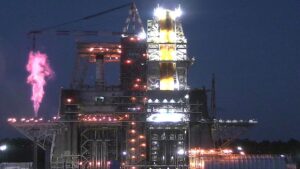NASA has scheduled a full-duration static-fire test of the SLS core stage at the Stennis Space Center for Jan. 16. Ignition is planned for 5 p.m. Eastern, with the engines firing for 485 seconds.
The test will be the culmination of the Green Run test campaign for the SLS core stage, which started almost exactly a year ago when the stage was installed on a test stand at Stennis. That series of tests included, most recently, a “wet dress rehearsal” Dec. 20 where the tank was loaded with liquid oxygen and liquid hydrogen propellants and went through a practice countdown.
That test, agency officials said at a Jan. 12 briefing, went well, with no signs of leaks or other major issues. “As a result of all the wet dress rehearsal testing, we really gained a lot of confidence in the hardware and in our ground support systems,” said Julie Bassler, SLS stages manager at NASA’s Marshall Space Flight Center.
That test was not perfect, though. The countdown stopped a few minutes before the scheduled end because of a timing problem with a valve. John Shannon, vice president and SLS program manager at Boeing, the prime contractor for the vehicle, said a liquid hydrogen fill-and-drain valve closed 0.2 seconds later than expected, halting the test. The issue was that helium used in the pneumatically actuated valve was colder than expected.
Shannon said they decided to adjust the timing to account for any such lags in the future. “We don’t have to be quite that precise and cut it quite that close, so we expanded the timer out so we’ve got sufficient margin,” he said.
The Dec. 20 test was the second attempt at the wet dress rehearsal. A test Dec. 7 stopped while still in its early phases because liquid oxygen flowing into the stage was warmer than expected. NASA attributed that problem to issues with ground systems, and not the SLS itself.
After that earlier test, NASA managers warned there was “very little margin” left in the schedule for a November 2021 launch of the SLS on the Artemis 1 mission, a point they reiterated at the briefing. If the hotfire test goes as planned on Jan. 16, the stage is scheduled to ship to the Kennedy Space Center in February to be integrated with its solid rocket boosters and upper stage, as well as the Orion spacecraft that will be launched on that uncrewed mission.
“Our team is locked in and focused on delivering the rocket for a 2021 launch. We’re continuing to look for opportunities to do things concurrently and improve our schedule,” John Honeycutt, SLS program manager at NASA, said.
Anticipating a successful test, workers at KSC have started stacking segments of the solid rocket boosters, a process that traditionally required the boosters to launch within 12 months. “It’s an opportunity for us to do some risk mitigation” regarding the stacking process, he said. He added they are collecting data about the boosters “to give us the best opportunity to do some sort of a life extension on the booster stacking in the event that we need that.”
Those plans, though, depend on getting through the Green Run successfully. “The reason we test is to learn, and from my perspective and the team’s perspective, we don’t want to do anything that puts the vehicle at risk,” Honeycutt said.
A successful test need not las the full 485 seconds. The key elements of the test are in the first few minutes, said Jeff Zotti, Aerojet Rocketdyne program director for the RS-25 engines that power the core stage. The four engines will ignite one at a time at intervals of 120 milliseconds and then power up to 109% of rated thrust. The engines will remain at that level for 90 seconds, then throttle back to 95% to simulate passing through maximum dynamic pressure, or Max Q, during ascent. After about a minute the engines will throttle back up to 109%.
“If we had an early shutdown for whatever reason, we get all of the engineering data that we need to have high confidence in the vehicle at about 250 seconds,” Shannon said, which includes both the engine throttling as well as some gimbaling of the nozzles. “But we’re going to go ahead and put it through the entire flight profile as long as everything is looking OK.”



